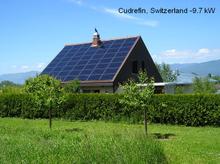The Department of Energy recently announced $168 million in grants for research into solar power. (Picture from GreenOptions.)
If we were serious about the War Against Oil there would be at least two more zeros in that number, plus a Truman Commission with teeth to make certain it wasn’t wasted.
American roofs can become the front line in the War Against Oil, but only if solutions are scaled and efficient.
Right now they are neither.
Silicon cells are expensive. Thin-film photovoltaics are inefficient. Quantum dots are years away from practical use. Our economic rivals (and real allies in this fight), Japan and China, are doing what they can. (Image from SunPower.)
But the challenge remains great, and for now the lab remains an important front in the war.
There are several materials that release electrons when exposed to
photons. The challenge is to capture these electrons as electricity,
then use, store, and transfer that electricity so it becomes available
to others. If the grid won’t do that, perhaps someone’s excess can be
stored as hydrogen through electrolysis, then either sold or used
later.
There is already a marketing infrastructure for home solar arrays which look a bit like regular roofs. Companies like PowerLight in Berkeley are already installing silicon-based solar roofs in new California homes. The trouble is the numbers don’t yet work. Thousands of dollars in government subsidies are required, per house, and you still wind up with a costly house.
Two photovoltaic materials are on offer. The PowerLight system is made by SunPower
and uses silicon, which is expensive and wears out. They claim to make
panels that are 20% efficient (capturing 20% of the solar radiation
hitting the panel). The theoretical limit for silicon is 29%, so
there’s not much further this technology can go in its present form.
CIGS (copper indium gallium selenide) is more efficient and can basically be sprayed-on, but it faces engineering problems. Miasole of Santa Clara is a leading producer. They call it thin film solar. Their Web site is far more primitive than that of SunPower, and they’re not nearly as far into exploiting the market.
Advocates of both technologies are looking to build factories overseas
to drive down costs. Which leads to this question. If we’re serious
about the War Against Oil, why aren’t solar equipment manufacturers
getting the same kind of incentives we’re giving car companies so they
will locate facilities here instead of elsewhere? If car plants are worth $150,000 in state funds per new job, what are solar plants worth?












